How Evidence Wins Cases
A personal injury case can hinge on a single piece of evidence, one key witness, or a seemingly minor detail that is easily overlooked. That's why we go to extraordinary lengths on behalf of our clients. Mr. Schafer particularly enjoys the intricate development of complicated cases, and the preparation of demonstrative evidence to make a case compelling. Over the years Mr. Schafer and our attorneys and paralegals have:
- Combed texts and journals at medical school libraries for literature to establish the standard of care for a physician.
- Visited an operating room to better understand how a surgical procedure was performed.
- Traveled across the country to speak in person with expert witnesses.
- Ridden on the top of an elevator car to examine and videotape the equipment in the shaftway.
- Videotaped an intersection for many hours over consecutive days to establish dangerous traffic patterns that led to a preventable collision.
- Visited schools throughout eastern Massachusetts to establish state-of-the-art in gymnasium design.
- Accompanied engineers to factories to observe industrial machinery in use, so as to better understand how an operator's injury could have been prevented.
- Photographed warnings on vintage tractors at a farm machinery museum in Montana , to build evidence on the role of warnings over the past century in preventing injuries on equipment.
- Spent days at the New York City Public Library researching advertising in trade journals, to establish the manufacturer's claims about the longevity of its equipment.
- Researched patents from the U.S. Patent Office to establish the feasibility of safety improvements.
- Sat with medical illustrators, model makers, and graphics designers to conceptualize and then revise demonstrative evidence for use in court.
These stories are not exceptions. They represent how we routinely approach our clients' cases.
From the inception of a case, we consider the types of "demonstrative evidence" that will bring alive key pieces of evidence and help a jury understand the case. Demonstrative evidence may consist of scale models, still photography and videotapes, maps, charts, diagrams, and graphs, case-specific technical and medical illustrations, microscopic enlargements, and the like.
To make up for the technological shortcomings of many antiquated courtrooms, we bring out own video presenter and video monitors to court to make it easier for jurors to see the evidence and to allow us to play PowerPoint presentations and similar programs.
The following contain examples of our work.
Scale Models Demonstrate Defective Products and Unsafe Machinery
Jury members are often unfamiliar with important mechanical details and key principles of physics. These details can be crucial to proving negligence in personal injury cases. Scale models show how machines are supposed to work.
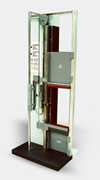
A maintenance worker opened the doors to a freight elevator and stepped into the shaft, not realizing that the elevator car was not at the floor, but one level below. He was seriously injured. An electrical and mechanical interlock mechanism should have prevented the doors from opening when the elevator car was not at the floor. Our inspection revealed that the interlock mechanism was stuck. We sued the elevator maintenance company for negligent upkeep of the elevator.
We worked with a professional model-maker to produce this life-sized, sectional model of the freight elevator doors, surrounding structure and mechanical equipment, using real components, and also installed an exemplar interlock mechanism to demonstrate how the locking system was supposed to work.

Forklift Model Demonstrates Tip Hazard
A truck driver stood next to a forklift as a delivery of plywood was being unloaded. Although the package of plywood seemed secure to the operator, the forklift tipped forward, spilling the sheets of plywood like a deck of cards and severely injuring the truck driver.
One of the hazards associated with forklifts is that they can tip forward if a load exceeds the forklift's lifting capacity. The lifting capacity varies, however, with the size, weight and center of mass of a load and the operator cannot always be certain that a load is within the safe lifting capacity of the machine.
We constructed these models of a teeter-totter and a forklift to show why a forklift can tip forward after it has lifted a load. Load-sensor controls could have prevented injury in the products liability case.

Wheel Assembly Model Demonstrates Weld Stress Points
A repairman lowered a large electric motor onto a 4-wheeled steel industrial truck and pulled on the truck’s handle to transport the motor to another location. The industrial truck tipped, causing the motor to fall onto the repairman, injuring him.
The wheels that were attached to the base of the industrial truck were found to have separated from the base, causing the truck to tip. Upon further inspection, the welds that attached the wheels to the base were determined to be defective because they had not penetrated the steel. This simple model was used to demonstrate to the jury how force was applied to the defective welds when the wheels swiveled, and why the welds finally failed at that time.
Digital Technology Helps a Jury Understand Landowner’s Negligence
 Digital Photography Demonstrates Need for Safety Mats in Gymnasium
Digital Photography Demonstrates Need for Safety Mats in Gymnasium
Digital photography can help jury members visualize before and after comparisons in personal injury cases.
Many old and new gymnasiums have limited run out space around their perimeters and no wall padding to protect players from injury if they run or are pushed into the walls.
In this recreational accident case, a college student slipped while running in this gymnasium, sliding across the floor and striking his head against the brick wall. He sustained a serious spinal injury. We found many gymnasiums - both vintage and new - where mats had been installed to prevent injuries from contact with the walls. We also found manufacturers' catalogs evidencing the availability of wall mats many decades ago. To demonstrate what the gym would have looked like and how safety would have been improved, we digitalized a photograph and inserted mats as they should have been placed around the perimeter.
Enlarged Historical Documents Emphasize Liability
 We routinely enlarge important documents or project them on a video presenter to monitors in the courtroom.
We routinely enlarge important documents or project them on a video presenter to monitors in the courtroom.
These examples of historic industry standards substantiate that the state of the art many decades ago required manufacturers to include guards on industrial machinery.
Enlarged Photographs of Accident Scene Focus Jury’s Attention
We frequently use PowerPoint presentations to show accident locations. This allows us to focus the jury's attention on significant landmarks, the direction of vehicles, and the vantage points of important witnesses.

In this automobile accident case, our client was crossing Commonwealth Avenue in Boston, when she was struck by a car operated by a driver for a fast food delivery service. These photographs show the driver’s approach to the intersection, the traffic controls, the walk light and crosswalk where our client was crossing, and the trolley tracks from which an MBTA engineer observed our client.
Demonstrating Altered Medical Records
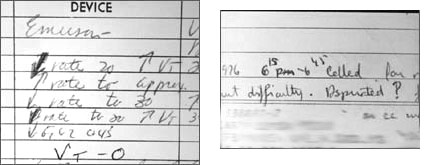 Our clients often worry that their medical records will be altered before they can obtain copies. Techniques exist to examine handwriting and printing to identify alterations in documents.
Our clients often worry that their medical records will be altered before they can obtain copies. Techniques exist to examine handwriting and printing to identify alterations in documents.
In this medical negligence case going back twenty-five years, our handwriting expert used special photography to enhance suspect areas of the medical record and reveal the original entries.
Anatomical Models Enhance Jurors’ Understanding of the Medical Issues

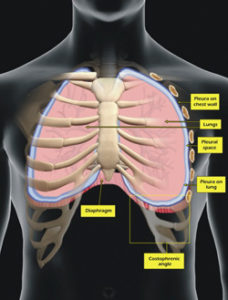 Medical Illustrations Explain Complicated Medical Issues
Medical Illustrations Explain Complicated Medical Issues
Anatomical Models Enhance Jurors’ Understanding of the Medical IssuesIn one tragic medical malpractice case, a graphic artist worked with one of our experts to create a scale model of an ocular tumor that had been missed during an eye exam by our client’s eye doctor.
Over the years we have compiled our own inventory of anatomical models for use in court. Nothing else so graphically explains the anatomy to jurors.
Color Enhanced Radiology Films Highlight Injuries
We work with medical illustrators to explain the anatomy to the jury and demonstrate the severity of a client's injuries. In the case depicted here, the black and white radiology films were enhanced to show in detailed color the appearance of internal structures. Our client sustained several traumatic injuries that, although of moderate severity individually, resulted in substantial disability and human damages when considered cumulatively.
Medical Calendars Explain Medical Treatment and Pain and Suffering
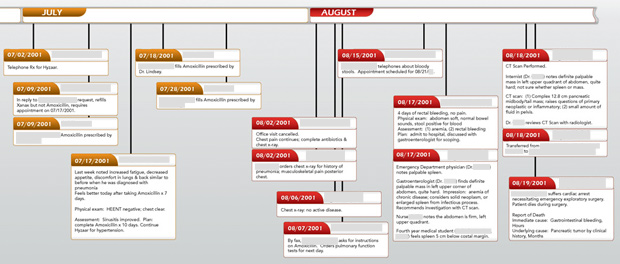
After carefully reviewing medical records, we often prepare customized and color-coded calendars to show the details of a client’s medical treatment. We used these calendars in one serious case to show the compelling elements of our client’s damages:
- Hospital admissions and doctor visits
- Surgeries, procedures and treatments
- Doses of multiple medications
- Progression of the disease
Electronic Fetal Monitor Tracings Demonstrate Obstetrical Malpractice
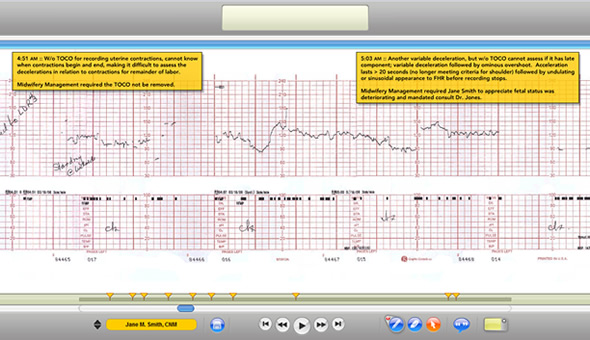
During labor and delivery, obstetricians, nurse-midwives, and labor and delivery nurses watch fetal monitor strips, or fetal heart tracings, for reassurance that the infant is tolerating the stress of the labor process. Transducers attached to the mother, and sometimes electrodes applied to the baby’s scalp, create tracings of the fetal heart rate and the mother’s uterine contractions. In these most devastating of medical malpractice cases involving catastrophically injured infants or stillborns, we work with technicians to create digitalized fetal monitor strips that demonstrate evidence of fetal distress or compromise during the labor and delivery process that were missed or ignored by the health care providers.

Learn How Evidence Wins Cases
A personal injury case can hinge on a single piece of evidence, one key witness, or a seemingly minor detail that is easily overlooked. Read More


